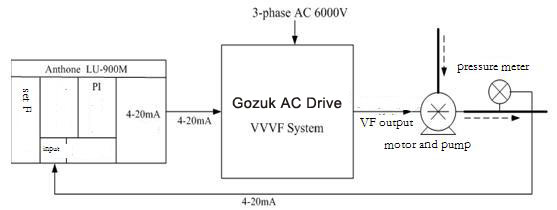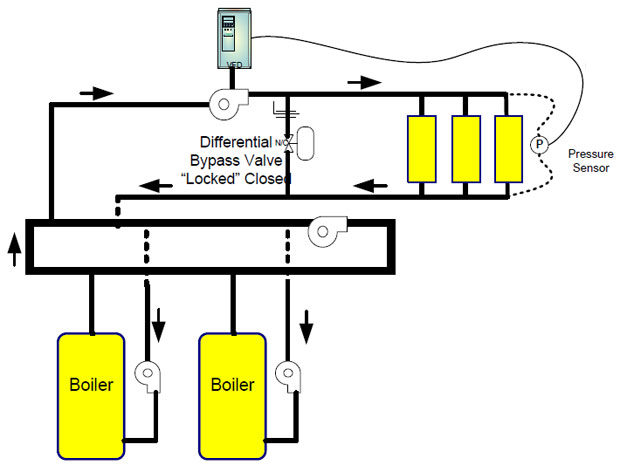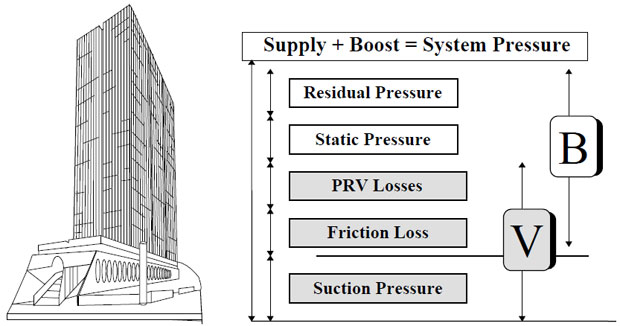Category
- Products
-
- FAQ
- Contact us

AC Drive Manufacturer
Home » Applications
For variable torque loads, motors are sized for the horsepower of the application as if they were on a sine wave across the line starter. Because pressure decreases with the square of the speed motor current flow is insignificant at low operating frequencies. For this reason there is little concern for motor overheating at low speeds. AC drives can give several benefits to centrifugal type applications including:
- Soft start and stop, prevents water hammering in pump applications and prevents sagging of the power line from high inrush that would occur with across the line starting.
- Mechanical wear and tear on belts & drive train components such as gearboxes are reduced.
- If a valve or damper is used for process control by restricting flow, significant energy savings can result by using an AC drive instead.
- If 2-speed motors are utilized, some energy savings can be achieved.
- Limiting speed when temperature changes occur in the air stream can control fan loading.
- Better process control than dampers or valves.
One of the most successful energy management tools ever applied to building HVAC systems is the AC drive (or variable speed drive). For more than 20 years, AC drives have successfully been installed on fan and pump motors in a range of variable load applications. Energy savings vary from 35 to 50 percent over conventional constant speed applications, resulting in a return on investment of six months to two years.
The basic benefit to using an AC drive is energy savings. By matching system capacity to the actual load throughout the entire year, major savings in system motor energy use are achieved.
Another benefit of the units is reduced wear and tear on the motors. When an induction motor is started, it draws a much higher current than during normal operation. This inrush current can be three to ten times the full-load operating current for the motor, generating both heat and stress in the motor's windings and other components. In motors that start and stop frequently, this contributes to early motor failures.
The basic benefit to using an AC drive is energy savings. By matching system capacity to the actual load throughout the entire year, major savings in system motor energy use are achieved.
Another benefit of the units is reduced wear and tear on the motors. When an induction motor is started, it draws a much higher current than during normal operation. This inrush current can be three to ten times the full-load operating current for the motor, generating both heat and stress in the motor's windings and other components. In motors that start and stop frequently, this contributes to early motor failures.
The output frequency of AC drive is controlled by a 4~20mA standard industrial signal which is from a LU-900M intelligent monitoring instrument with PI controller. The instrument input a 4-20mA pressure signal of pipe. Adjust set value through the meter panel which can implement non-disturbance switch for open/close loop control. The system figure as below:

The motor's current of water supply pump is about 120~130A before reform, and 90~110A after the reform.
Flow is basically same. Current of heat supply network circulating pump is about 55A, After the reform, it comes to 45A.
Since the AC drive was used, it has been running stably and greatly. It improves the site operating state, and reduces the working strength of the operators. Most of all, the station service labour decreases obviously. In 2006, for better effect we purchased four sets of AC drive for the boilers' fans again. We do believe more and more AC drives would be used in thermal- power corporations for building a more conservation-minded society.

The motor's current of water supply pump is about 120~130A before reform, and 90~110A after the reform.
Flow is basically same. Current of heat supply network circulating pump is about 55A, After the reform, it comes to 45A.
Since the AC drive was used, it has been running stably and greatly. It improves the site operating state, and reduces the working strength of the operators. Most of all, the station service labour decreases obviously. In 2006, for better effect we purchased four sets of AC drive for the boilers' fans again. We do believe more and more AC drives would be used in thermal- power corporations for building a more conservation-minded society.
This application gives the perfect solution for the problem and operation conditions in water feeding system. With analysis and demonstration, we think the reform of AC drive could resolve these problems and make a good economic benefit.
Using the variable frequency control technology is one of the important methods to solve the problem. Controlling feed pump by AC drive can achieve the flow control in variable load. It solves the problem and improves the reliability of the system; furthermore, it decreases the throttle loss, reduces the wear and tear of the valve and damage on seal of the pipe, makes the equipment work longer, reduces the maintenance, improves the economic benefit of the system, saves energy and provides a good way to reduce power consumption of plant.
Using the variable frequency control technology is one of the important methods to solve the problem. Controlling feed pump by AC drive can achieve the flow control in variable load. It solves the problem and improves the reliability of the system; furthermore, it decreases the throttle loss, reduces the wear and tear of the valve and damage on seal of the pipe, makes the equipment work longer, reduces the maintenance, improves the economic benefit of the system, saves energy and provides a good way to reduce power consumption of plant.
After condensating, vapour which does work in low pressure cylinder of steam turbine is collected in condensing water tank. Condensing pump delivers condensing water to deaerator in time to maintain level balance. So continuous and stable operation of condensing pump is one of important factors which ensure generator safety and economized production.
Before using medium voltage AC drive, water level of condenser is adjusted by changing outlet valve opening. Linearity is inferior and lots of energy wastes on valve. In the mean time, frequent operation on valve leads to valve reliability down, affecting stable operation of system.
After using AC drive, no need to adjust outlet valve. Valve opens at a large scope. Adjusting AC drive output frequency changes motor speed, reaching purpose of outlet flow adjustment. Following is condensing water system:

Before using medium voltage AC drive, water level of condenser is adjusted by changing outlet valve opening. Linearity is inferior and lots of energy wastes on valve. In the mean time, frequent operation on valve leads to valve reliability down, affecting stable operation of system.
After using AC drive, no need to adjust outlet valve. Valve opens at a large scope. Adjusting AC drive output frequency changes motor speed, reaching purpose of outlet flow adjustment. Following is condensing water system:

A major Perth hotel installed AC drives on its air conditioning fans, improving conditions, reducing noise and cutting fan-related energy costs by about 40%.
The initial installation had throttling dampers installed in the supply air ductwork. As the requirement for airflow decreased, these dampers closed to reduce airflow to the rooms.
Not only was this method of flow control inefficient in terms of energy use, it was noisy and required regular maintenance.
The hotel determined that installing AC drives on the fans would save energy, improve system performance and lower maintenance costs.
After a trial run, the hotel installed AC drives on each of the guests' rooms supply air fans. The work included disconnecting the existing supply air dampers, upgrading the air conditioning control systems and installing the new AC drives.
The initial installation had throttling dampers installed in the supply air ductwork. As the requirement for airflow decreased, these dampers closed to reduce airflow to the rooms.
Not only was this method of flow control inefficient in terms of energy use, it was noisy and required regular maintenance.
The hotel determined that installing AC drives on the fans would save energy, improve system performance and lower maintenance costs.
After a trial run, the hotel installed AC drives on each of the guests' rooms supply air fans. The work included disconnecting the existing supply air dampers, upgrading the air conditioning control systems and installing the new AC drives.
The bypass valve and electromechanical pressure control is replaced by an AC drive to control the pump and a new differential pressure sensor (see Figure 2). The pump speed (flow) is modulated to maintain system pressure. Placing the differential pressure sensor as shown ( farthest along the zone loop) can further increase control and possible savings.


This application introduces the application of AC drive reform on Condensing pump in 300MW power plant, states the operation mode and energy saving effect after the reform. The total capacity is 8 × 300MW. Steam turbine unit is produced by Dongfang factory. The condensing system of 5, 6, 7, 8 are medium pressure system, equipped with 9LDTNA-5UA-type condensing pump made by Shenyang pump factory. The motor YLST500-4 type is made by Xiangtan Electrical Machinery Factory.
(1) The reform is safe and reliable. It reduces the vibration of condensing water pipeline and temperature of motor coil.
(2) The reform cancels throttle adjustment. Energy-saving for the condensing pump is obvious.
(3) Personnel must take care in checking , especially for maintenance and check of AC drive.
(1) The reform is safe and reliable. It reduces the vibration of condensing water pipeline and temperature of motor coil.
(2) The reform cancels throttle adjustment. Energy-saving for the condensing pump is obvious.
(3) Personnel must take care in checking , especially for maintenance and check of AC drive.
Figure 2 shows how the system may be retrofitted to a variable volume system - with an AC drive controlling the fan speed. The discharge air sensor (DA-T) controls the mechanical equipment to keep the temperature in the duct constant. The room sensor controls the ac drive. The principle of operation is very much like how a variable volume terminal box would operate. Temperature in the space is controlled by keeping the supply temperature the same and varying the volume of air delivered in to the space.


This paper introduced principal, function and characteristics of AC drive coordination control technology, explains a new method of energy saving without modification for DCS and control logics. A 100MW machinery unit is 380t/h coal powder furnace. The ID fan system is driven by two motors 6kV/800kW. In order to save energy, improve ID fan efficiency, reduce damper adjustment loss, user decides to choose stable and reliable AC drive reconstruction.
Because the DCS was changed for several times, the spare I/O ports are not enough for AC drive construction. There is a question that how to realize AC drive reconstruction without modification for DCS and control logic. After deep research in AC drive characteristics, furnace operation technology and DCS structure, we put forward a new technology (HCU for abbreviation) which can save energy without modification for DCS and control logic.
Because the DCS was changed for several times, the spare I/O ports are not enough for AC drive construction. There is a question that how to realize AC drive reconstruction without modification for DCS and control logic. After deep research in AC drive characteristics, furnace operation technology and DCS structure, we put forward a new technology (HCU for abbreviation) which can save energy without modification for DCS and control logic.
There has been a lot of debate in the plumbing engineering community regarding the use of AC drives (or variable frequency drive, VFD) in domestic water pressure booster system applications. The debate centers on energy savings and whether or not there is a reasonable payback for building owners on the additional first cost of a variable speed system. This paper will shed some light on the issue, and perhaps provide design engineers with some tools to better understand when AC drives (AC drives) make sense.

In analyzing the practicality of using AC drives, we must now consider which variations of the above parameters yield energy savings when varying the speed of the booster pumps. Of the above five factors, static height and residual pressure generally do not change. As such they will have little or no impact and hence will yield no opportunity to vary the speed of the pumps.

In analyzing the practicality of using AC drives, we must now consider which variations of the above parameters yield energy savings when varying the speed of the booster pumps. Of the above five factors, static height and residual pressure generally do not change. As such they will have little or no impact and hence will yield no opportunity to vary the speed of the pumps.
Medium voltage AC drives are applied in generators of 100~600MW. Main equipment is PA fan, ID fan, FD fan and condensing pump.
Power plant should realize its society responsibility, take energy saving and emission reduction as internal dynamic of sustainable & healthy development. Plant should put energy saving into agenda, promote energy saving by new material, new technics and technology development.
Power plant should realize its society responsibility, take energy saving and emission reduction as internal dynamic of sustainable & healthy development. Plant should put energy saving into agenda, promote energy saving by new material, new technics and technology development.

